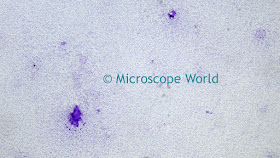The
Fruit & Flower Prepared Microscope Slide Kit contains beautiful prepared slides that are ready to view under a
biological microscope. This prepared slide set is the perfect gift for someone who already has a microscope, but might be looking for something new to view under their microscope. The Fruit & Flower Prepared Slide Kit contains the following prepared slides: (All images below were captured using the
Richter Optica U2-D digital biological microscope.)
 |
| Cucumis Staminate Flower prepared slide under the microscope (100x) |
The Cucumis Staminate Flower is better known as the stamen from the cucumber family, including melons.
 |
| Ranunculus prepared slide under the microscope (100x) |
Ranunculus are a colorful flower group that includes buttercups, spearworts and water crowfoots.
 |
| Monocot and Dicot of Flower Bud prepared slide under the microscope (40x) |
Monocot and Dicot of flower buds are beautiful and typically product amazing colors in prepared microscope slides.
 |
| Capsella of Bud prepared slide under the microscope (400x) |
Capsella of Bud is a mature embryo with Cotyledons. Capsella is a genus of herbaceous plants and biennial plants in the mustard family.
 |
| Wheat prepared slide under the microscope (40x) |
Wheat is the third-most produced cereal grain in the world behind maize and rice.
 |
| Pear prepared slide under the microscope (400x) |
Pears are grown both as an edible fruit and for the beauty of their ornamental trees.
 |
| Corn Seed prepared slide under the microscope (100x) |
Corn (also known as Maize) is a large-grain plant that is a monocot.
 |
| Pollen prepared slide under the microscope (100x) |
Pollen is a fine to coarse powder that contains microgametophytes of seed plants, which produce male gametes. Pollen is involved in the reproduction of plants.
 |
| Lilium prepared slide under the microscope (40x) |
Lilium is a genus of herbaceous flowering plants growing from bulbs, all of which have large and prominent flowers (including Lilies).
 |
| Capsella prepared slide under the microscope (100x) |
Capsella is part of the mustard family.











































